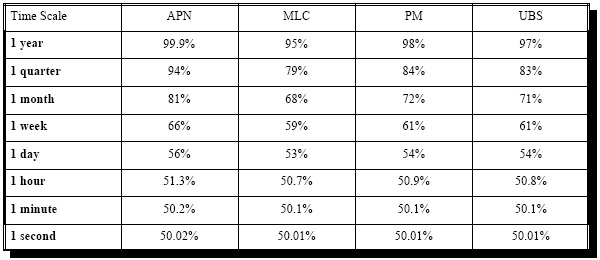How often should an investor/trader check the performance of their positions? Does it make a difference (psychologically) whether one checks frequently or infrequently? In their 2005 paper entitled “The Scaling Property of Randomness: The Impact of Reporting Frequency on The Perceived Performance of Investment Funds”, Nigel Finch, Guy Ford, Suresh Cuganesan and Tyrone Carlin use actual investment fund performance data to explore the likelihood that an investor would have viewed the performance as positive or negative based on sampling frequency. Applying prospect theory (a loss in wealth has a negative impact 2.25 times greater in magnitude than the positive impact of a gain in wealth) to data for four large Australian investment funds (see table below), they conclude that:
- The shorter the sampling interval, the lower the probability (approaching 50%) that a fund will show a gain. (See the second table below.)
- Fund holders checking their balances at intervals of less than approximately one month are likely to have negative feelings about their investments.
- Fund holders checking their balances at quarterly or annual intervals are very likely to have positive feelings about their investments.
- Funds that want to hold onto their investors should report as infrequently as feasible.
The following table, taken from the paper, profiles the four Australian funds used in the test. All have five-star Morningstar ratings as of the test date, showing relatively high average annual returns and relatively low volatility.

The next table, also taken from the paper, shows the probability of seeing a gain in fund value by sampling interval (assuming underlying distributions of returns are normal). Sampling intervals tested range from one second to one year. For example, the probability of seeing a gain after a randomly selected one-minute interval is just barely over 50% for all four funds. The probability of seeing a gain after a randomly selected one-year interval is at least 95% for all four funds.

In summary, investors/traders who check investment performance frequently should make mental adjustments for pain-avoidance bias.